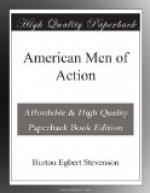Let us return to Hampton Roads.
The news of the disaster to the Union fleet spread gloom and consternation throughout the North, and corresponding rejoicing throughout the South. The remaining ships in Hampton Roads plainly lay at the Merrimac’s mercy, and after they had been destroyed, there was nothing to prevent her steaming up the Potomac and attacking Washington. It seemed as if nothing but a miracle could save the country from awful disaster.
And that miracle was at hand.
Among the coincidences of history, none is more remarkable than the arrival at Hampton Roads on the night of March 8, 1862, of the strange and freakish-looking craft known as the Monitor. Proposed to the Navy Department in the preceding fall by John Ericsson, in spite of sneers and doubts, a contract was given him in October to construct a vessel after his design. The form of the Monitor is too well known to need description—“a cheese-box on a raft,” the name given her in derision, describes her as well as anything. She was launched on the last day of January, and three weeks later was handed over to the Government, but it was not until the fourth of March that her guns were mounted, two powerful rifled cannon. At the request of Ericsson, she was named the Monitor, and this name came afterwards to be adopted to describe the class of ships of which she was the first. So dangerous was service in her considered, that volunteers were called for, and Lieutenant John Lorimer Worden was given command of her.
Worden had entered the navy twenty-seven years before, and at the opening of the Civil War, had delivered the orders from the secretary of the navy which saved Fort Pickens, in the harbor of Pensacola, to the Union. Attempting to return North overland, he was arrested and held as a prisoner seven months, being exchanged just in time to enable him to procure command of the Monitor. Rumors of the construction of the Merrimac had reached the North, and two days after her guns were aboard, the Monitor left New York harbor for Hampton Roads. Just after she passed Sandy Hook, orders recalling her were received there, fortunately too late to be delivered. By such slight threads do the events of history depend.
Meanwhile, Captain Worden was making such progress southward as he could with his unwieldy and dangerous craft, which had been designed only for the smooth waters of rivers and harbors and which was wholly unable to cope with the boisterous Atlantic. There was a brisk wind, and the vessel was soon in imminent danger of foundering. The waves broke over her smoke-stack and poured down into her fires, so that steam could not be kept up; the blowers which ventilated the ship would not work, and she became filled with gas which rendered some of her crew unconscious. Undoubtedly she would have gone to the bottom very shortly had not the wind moderated. Even then, it was almost a miracle that she should win through, but win through she did, and at four o’clock on the afternoon of Saturday, March 8, as she was passing Cape Henry, Captain Worden heard the distant booming of guns. As darkness came, he saw far ahead the glare of the burning Congress.




